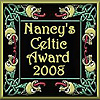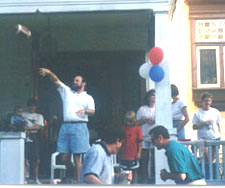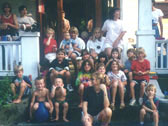| |

Traditions, folklore, history and more. If it's Irish, it's here. Or will be!
"People will not look forward to posterity who never look backward to their ancestors."
-Edmund Burke




Quotes
Library: Books, Movies, Music
Prints & Photos
Poetry
Jokes


Shops Ireland
Bunús na Gaeilge
(Basic Irish)
Circle of Prayer
Blessings
Did You Know?
Himself/Herself
Write to Us
Readers Write..
Links/Link to Us
Advertise with us
Awards & Testimonials
Submissions Guide


|
|
|
From our Front Porch - July 4th
by Bridget Haggerty
 On the Sunday afternoon closest to the 4th of July, they descended on Haggerty's Toad Hall - the McCloys, Calhouns, Kellys, Aherns, and O'Flahertys. Armed with coolers, fireworks, lawn chairs, extra grills, and dishes to share, the stage and cast were set for an old-fashioned Independence Day picnic. On the Sunday afternoon closest to the 4th of July, they descended on Haggerty's Toad Hall - the McCloys, Calhouns, Kellys, Aherns, and O'Flahertys. Armed with coolers, fireworks, lawn chairs, extra grills, and dishes to share, the stage and cast were set for an old-fashioned Independence Day picnic.
For our part, we'd been making preparations for days. Out came the garland of red, white and blue pennants which we tied from tree to tree around the property. We put the local used car lot to shame.
Window boxes on the patio had been planted in May and now rewarded us with patriotic blossoms - red geraniums, blue ageratum and white petunias. The fridge and larder were loaded. Groaning with hamburger, hotdogs, pickles and condiments. Sparklers had also been purchased as well as paper goods, beverages, beer and balloons. Hundreds of balloons.
On the morning of the picnic. Bridget made deviled eggs and her famous potato salad; Russ hung the flags and checked on sporting equipment. Up went the badminton net and out came the croquet set. We then blew up dozens of balloons which were attached in bunches to the ends of badminton posts, on porch rails, and anywhere else they'd make a good show.
Joining all of the Irish-Americans mentioned at the beginning of this article were a slew of many more friends; their names recalling other immigrants and their descendants: Schupp, Jones, Gonzales, Schultz, Abare, Bonar, Butler, Nimershiem, Brown, Post, Schluter, Talerico. A reminder that, while Irish-Americans make up a huge part of our population, we are indeed a Heinz 57 group, consisting of people from lands far and wide.
 At our house, the July 4th picnic was always the favorite Haggerty party. This was the one where you could brings the kids, dress for total comfort and just sit back and relax. No hustle and bustle of Christmas; no time-consuming creation of a costume for Halloween; and no worries about formal attire for New Year's Eve. Indeed, the only other Haggerty party that ever came close in popularity was our St. Paddy's Day Bash; but, since that one didn't include the kids, it's a far cry from July 4th which will always remain our favorite. Maybe it's remembering the Sousa marches blasting from the boom box. Or, it might be the egg-toss followed by the balloon toss - orchestrated so that balloons bursting in air or on people would wash off eggs turned into missiles exploding everywhere. At our house, the July 4th picnic was always the favorite Haggerty party. This was the one where you could brings the kids, dress for total comfort and just sit back and relax. No hustle and bustle of Christmas; no time-consuming creation of a costume for Halloween; and no worries about formal attire for New Year's Eve. Indeed, the only other Haggerty party that ever came close in popularity was our St. Paddy's Day Bash; but, since that one didn't include the kids, it's a far cry from July 4th which will always remain our favorite. Maybe it's remembering the Sousa marches blasting from the boom box. Or, it might be the egg-toss followed by the balloon toss - orchestrated so that balloons bursting in air or on people would wash off eggs turned into missiles exploding everywhere.
Then again, it could be the memory of the year it poured down in buckets; we had umbrellas set up over the grills and dads wearing ponchos. Bridget had created an Ice Cream Parlor on the bar. All of the kids - some soaking wet and trailing grass clippings from a freshly-mowed lawn - traipsed through the house and lined up for their cone. If they wanted Jimmies, they got Jimmies. If they wanted whipped cream, hot chocolate syrup and a maraschino cherry on top, that was okay, too. One of the guests was aghast. "Bridget, they're destroying your house!" Maybe so. But it was July 4th. And in some ways, "let freedom ring" never had a sweeter meaning than seeing those kids happy as clams devouring their cones on our front porch.
For while grass stains do take a bit to remove, we thank our lucky stars and stripes that the memories of July 4th at the Haggertys are indelibly imprinted on our hearts. We also remember that we are just a few bit players in the ever-enfolding saga of the Irish in America. We salute the brave kinsmen who journeyed here to start a new life and we congratulate all Irish-Americans for the incredible contributions they have made to life in these United States. If you've ever wondered about the Irish influence on the U.S.A, here's just a partial list:
Nellie Bly (born Elizabeth Cochrane, 1864-1922): Journalist and adventuress who went around the world in 72 days.
Matthew Brady (1823-1896): Civil War photographer.
William J. Brennan, Jr. (1906-1997): U.S. Supreme Court Justice.
James Cagney (1904-1986): Actor whose Oscar-winning role in 1942 was in Yankee Doodle Dandy, the life of Irish-American composer George M. Cohan.
Charles Carroll III* (1737-1832): The only Catholic to sign the Declaration of Independence, Carroll was born in Maryland, whose laws at the time prohibited Catholics from voting, holding office, worshipping openly, or educating their children as Catholics. Despite this rampant anti-Catholic prejudice, Carroll took an active part in the Revolution, using his business acumen to help the colonies arm themselves against Britain. He served as a U.S. Senator in the first Congress, and when he died was reputedly the richest man in America.
Buffalo Bill Cody (1846-1917): Western scout and showman.
George M. Cohan* (1872-1942): The father of American musical comedy, Cohan was born into theater. He gradually worked his way from his family's vaudeville troupe to Broadway, where by the 1920s he was doing ten productions in a single year. In his long career as author, composer, director and performer, this powerhouse of the popular stage had a favorite theme: star-spangled patriotism. His World War I composition, Over There, won him a Congressional Medal, while I'm a Yankee Doodle Dandy brought the honor of defining what it meant to be an American.
Father Charles Coughlin* (1891-1979): Having spent his childhood in Ontario, Canada, Father Coughlin moved in 1926 to Royal Oak, Michigan to serve as pastor of a new church, the Shrine of the Little Flower. This small parish in a largely Protestant community soon found itself menaced by an active Ku Klux Klan. Coughlin needed a broader constituency (for financial reasons as well as solidarity) and so he began broadcasting his sermons over a local radio station. By 1930, the magnetic priest had won a national audience of 40 million listeners. But Coughlin wasn't just lecturing about religion. In these post-Crash years, the radio priest was campaigning against the gold standard and Wall Street, decrying the evils of modern capitalism. When Franklin Delano Roosevelt was elected in 1932, Coughlin called him the salvation of the nation. But his adoration soon turned bitter: Coughlin thought the New Deal monetary reform was moving too slowly. He launched his own political organization -- the National Union for Social Justice -- and became passionate in his hatred of Roosevelt, calling the New Deal a communist conspiracy. In 1938 he also turned against Jews. He began expressing sympathy for Hitler and Mussolini. This rapid extremism lost him many supporters. In 1940 he ran out of money for his broadcasts; two years later Coughlin withdrew from the political fray. He maintained his parish duties until 1966.
Davy Crockett* (1786-1836): Born to a pioneer family living on the Nolichucky River in east Tennessee, Crockett eventually made his home in the northwest corner of the state. A member of the Tennessee militia, Crockett's second enlistment was under Andrew Jackson at Pensacola. His political career advanced quickly; he spent several terms in Congress as a Democrat, but eventually broke with Jackson. After only one term as a Whig, he gave up on politics and reportedly said, "You can all go to Hell and I'm going to Texas." He settled in east Texas in 1835 and died when the Alamo fell a year later.
Harry L. "Bing" Crosby (1904-1977): Entertainer who made over 850 recordings and appeared in over 50 films, including Going My Way for which he won an Oscar in 1944.
Richard J. Daley (1902-1976): mayor of Chicago from 1955 until his death.
Dorothy Day (1891-1980): Journalist and peace activist; founder of the Catholic Worker movement.
Mary Harris Jones ("Mother Jones") (1830-1930): Foremost labor agitator in the United States; helped organize the International Workers of the World (IWW).
F. Scott Fitzgerald (1896-1940): Novelist and author of, among others, The Great Gatsby (1925).
Elizabeth Gurley Flynn (1890-1964): labor activist and organizer for the Industrial Workers of the World ("IWW"); first woman to head the U.S. Communist Party.
John Ford (1895-1973): Film director who won Oscars for The Informer, The Grapes of Wrath, How Green Was My Valley, The Battle of Midway and December Seventh.
Henry Ford (1863-1947): Pioneering automobile manufacturer.
Jackie Gleason (1916-1987): Actor best known for his role as Ralph Kramden in The Honeymooners.
W.R. Grace (1832-1904): Business leader, steamship line operator and first Roman Catholic mayor of New York.
Helen Hayes (1900-1993): The "first lady of American theater," who won Oscars for The Sin of Madelon Claudet and Airport.
William Randolph Hearst (1863-1951): Editor and publisher of the largest newspaper chain in America; member of Congress.
John Joseph Hughes* (1797-1864): A native of County Tyrone, at the age of 21, Hughes emigrated to America, where he found work on the canals and later as a seminary gardener. It was in the United States that he began studying for the priesthood. He was ordained in 1826 in the Philadelphia diocese, and in 1842 became archbishop of New York. An outspoken leader of the city's Catholic community, he vigorously promoted the growth of parochial schools. He was also the force behind the building of a new cathedral in 1858.
Andrew Jackson* (1767-1845) Born in the Carolina hills to an immigrant farming family from Ireland, Jackson fought in the Revolution at the ripe-old age of 11. By the end of the war, he was alone, all but one member of his immediate family dead from the conflict. He decided to study law and to head farther west. By the time he was 30, he had been elected to Congress, won a seat on the supreme court of Tennessee, and set up a modest estate that would soon become a major cotton plantation. However, it was his military career that won him national recognition. During the War of 1812, Jackson's troops crushed the Creek Indians and then, at the Battle of New Orleans, the British. In 1821 he was named military governor of the Florida Territory; in 1828 he defeated John Quincy Adams to become the 7th President of the new Republic. Jackson appealed to the common man and in many ways advanced the causes of majority rule: he waged war on the Second Bank of the United States for the power that it gave to a few unelected bankers, and he sought to build a new mass political party. Yet Jackson's vision of democracy was limited: he condemned abolitionism and brutally subjugated Native Americans.
Buster Keaton (1895-1966): Vaudevillian and early film star.
Gene Kelly (1912-1996): Entertainer who danced his way into American hearts in the musicals On the Town, An American in Paris and Singin' in the Rain.
Grace Kelly (1928-1982): Film and stage actress, who won an Oscar for The Country Girl, she was also Princess Grace of Monaco.
John Fitzgerald Kennedy * (1917-1963) Kennedy's political career began in 1946, in a run for Congress in the district where his parents had been born. The working-class community which elected him was not his; Kennedy had gone to Choate and Harvard and lived an almost aristocratic life. Yet he had a sense of history and learned quickly. His election in 1960 as the 35th President of the United States -- the first Roman Catholic to hold that office -- was a crowning triumph for the Irish.
Joseph P. Kennedy* (1888-1969): Born in East Boston and educated at Harvard, Kennedy began his swift climb to fortune as a bank president. He quickly amassed millions in the pre-Depression stock market. After the Crash of 1929, power shifted from Wall Street to Washington, and Kennedy made himself a confidante of President Roosevelt. Roosevelt named him chairman of the newly formed Securities and Exchange Commission (SEC) in 1934, and in 1937, Ambassador to England. The first Irish Catholic Ambassador to the Court of St. James, Kennedy served in that role until 1940. Rumors that he favored appeasement soured his relationship with Roosevelt and dimmed his own political career. But Kennedy's ambitions never faltered. He turned his attention to his sons, three of whom became United States senators and one, the 35th President.
George Meany (1894-1980): President of the American Federation of Labor; instrumental in merger of AFL with CIO.
Eugene McCarthy (1916- ): Congressman from Minnesota; candidate for President in 1968.
Joseph McCarthy (1908-1957): Senator from Wisconsin.
Mary McCarthy (1912-1989): Writer and author of, among others, The Group.
John McCloskey (1810-1885): First American cardinal of the Roman Catholic Church.
Joseph McKenna (1834-1926): US Attorney General and Justice of the Supreme Court.
Andrew W. Mellon (1855-1933): Banker, capitalist and Treasury Secretary under President Harding.
Edward R. Murrow (1908-1965): CBS correspondent.
Flannery O'Connor (1925-1964): Novelist and short-story writer; author of, among others, A Good Man is Hard to Find and Other Stories.
Sandra Day O'Connor (1930- ): First female Supreme Court justice, appointed in 1981.
John O'Hara (1905-1970): Novelist and short-story writer; author of, among others, Butterfield 8 and From the Terrace.
Georgia O'Keefe (1887-1986): Painter.
Eugene O'Neill* (1888-1953): Son of a matinee idol best known for his portrayal of the Count of Monte Cristo, O'Neill attended Princeton briefly, then fled his immigrant family and its lace-curtain respectability. For 6 years he wandered, making his home in waterfront bars and brothels. A bout of tuberculosis in 1912 brought his reckless living to an end, and in the solitude of a hospital, O'Neill began writing plays. Within a decade, he had won a Pulitzer and a reputation as the one-time down-and-outer who created works of high art. He became a cultural hero, an American success. And yet he wondered if it was all worthwhile. After winning the Nobel Prize for Literature in 1936 (the first American playwright to do so), O'Neill turned his back on Broadway; he turned instead to the past, to his family's passage from Irish peasant to Nobel laureate. It is during these years that he wrote the Irish masterpieces, The Iceman Cometh, Long Day's Journey Into Night, and Moon for the Misbegotten, the work for which he would be remembered. In 1944, he put his pencil down and never wrote again.
Gregory Peck (1916- ): Oscar-winning actor whose roles included To Kill a Mockingbird.
Margaret Sanger (1879-1966): Pioneer birth-control advocate.
Alfred E. Smith* (1873-1944): Born on New York's Lower East Side, Al Smith left school before he'd finished the eighth grade and worked for 6 years at the Fulton Fish Market. But politics was the road upward for the Irish. Smith began by running errands for the Tammany boss, Tom Foley. When he was 22, he got a paying job serving subpoenas and from there on, the opportunities multiplied. In 1903 he won election to the state legislature. Several terms later, in 1915, he was elected Sheriff of New York City, then President of the Board of Aldermen, and finally Governor of New York. In four terms as Governor, Al Smith would change the focus of government, instituting rent control, subsidized housing and hospital care, price limits on electric power, heat, and telephones. In 1928, with the backing of Governor Franklin Delano Roosevelt, Smith won the Democratic presidential nomination. Feelings of great pride in the Irish American community would soon turn to bitterness and shame, as religion became the issue of the campaign and Herbert Hoover rode the tide of anti-Catholicism into the White House. Smith suffered another blow in 1932, when President Roosevelt kept Smith out of his New Deal government.
Alexander T. Stewart (1803-1876): entrepreneur; "invented" the American department store.
Ed Sullivan (1902-1974): Journalist and television producer, whose Ed Sullivan Show ran for 22 years.
John L. Sullivan* (1858-1918): Born in the Roxbury section of Boston, Sullivan made his name one night in the Dudley Street Opera House, when he knocked a professional fighter into the orchestra pit and boldly announced to the crowd, "My name is John L. Sullivan and I can lick any man in the house." Three years later he got a title fight with Paddy Ryan, another in the distinguished line of world champions. John L. knocked him out in eleven minutes -- and declared himself champion of the world. Then he did what no man had ever done before: he challenged America, offering a thousand dollars to any man, anywhere, who could stay on his feet for four rounds. And wherever he went, the Irish came out to cheer him. He became a very rich man, of indisputable elegance; a real hero. His career would have its ups and downs, as would his personal reputation, but even when he was old and gray, John L. took to the road, shaking hands along the way. He knew the Irish needed a hero they could touch.
Louis H. Sullivan (1856-1924): Modernist architect and father of the skyscraper.
To add icing to the cake, nine Irish-Americans signed the Declaration of Independence.
Hope it makes you proud.
So, fly the flag high and have a safe and happy 4th of July.
|
|
Thu, Apr 4, 2024
 Ilnacullen, Co. Cork - an Island Garden Ilnacullen, Co. Cork - an Island Garden
Located in the sheltered harbour of Glengarriff in Bantry Bay. Ilnacullin, which means island of holly, is a small island known to horticulturists and lovers of trees and shrubs all around the world as an island garden of rare beauty.
The vivid colours of Rhododendrons and Azaleas reach their peak during May and June, whilst the hundreds of cultivars of climbing plants, herbaceous perennials and choice shrubs dominate the midsummer period from June to August.
Because of its sheltered situation and the warming oceanic influence of the Gulf Stream, the climate is favourable to the growth of ornamental plants from many parts of the world.
Even for those who aren’t particularly interested in gardens, there are many other scenic views, especially in the surrounding waters where seals frequent the rocks on the southern shore.
The cover photo on Bridget's book The Traditional Irish Wedding shows a wrought iron garden gate on Ilnaculen. I took that photo. To see it, go to the home page. It's part of the opening paragraph Failte.
—Russ
Resource: Copy and Image - Cork Guide
Click for More Culture Corner.
We have this book and it's a gem. We now wish we had this up-dated edition. But don't take our word for it - here's another opinion from an amazon reviewer: This is not your average travel book containing descriptions of places, events, lodging, exchange rates, etc. Instead, it gives the nitty gritty on how to conduct yourself in your day-to-day life. Especially enjoyable was the chapter entitled "Paddies", which gives a valuable groundwork in dispelling myths and stereotypes surrounding the Irish and Ireland. Entertaining and informative, this book will help visitors to Ireland get more out of their visit.
Click here for Culture Shock.
|
...for all 'decent skins', 'crawthumpers', horse-protestants', 'hard chaws' and 'strong farmers'...a dictionary of Irish slang that's as amusing as it is informative.
Click here for Slanguage
|
|
|
|
|




 Ilnacullen, Co. Cork - an Island Garden
Ilnacullen, Co. Cork - an Island Garden